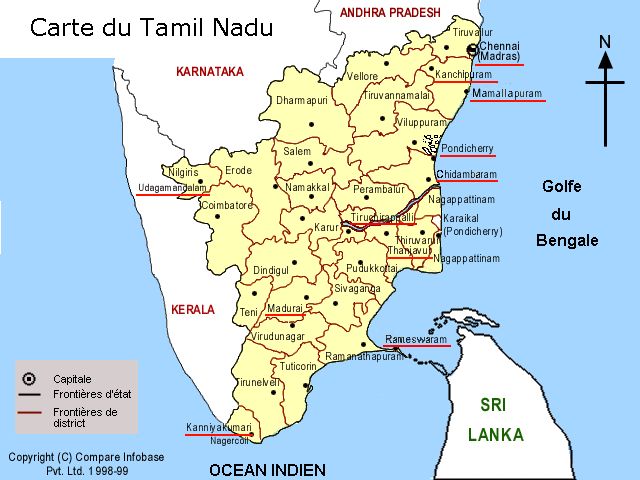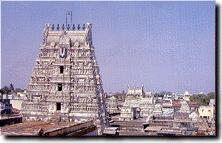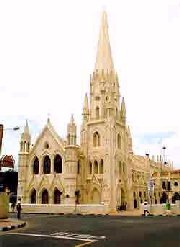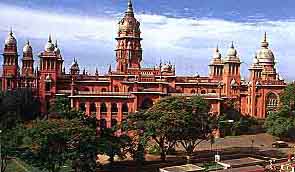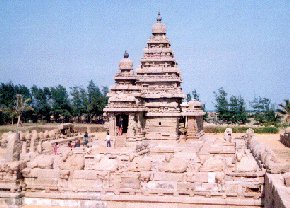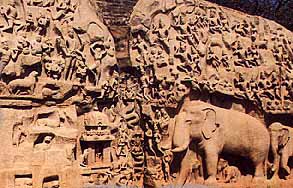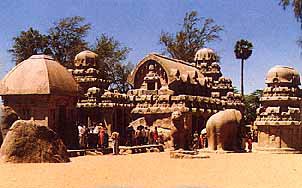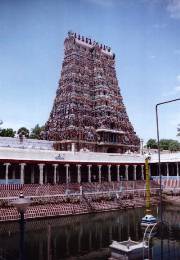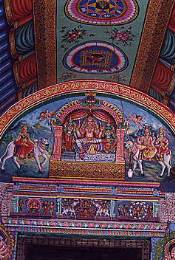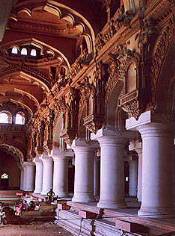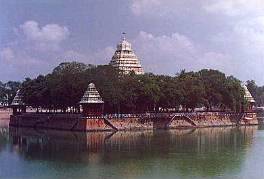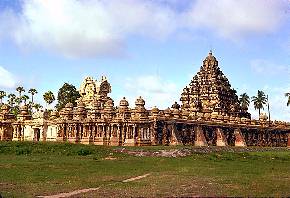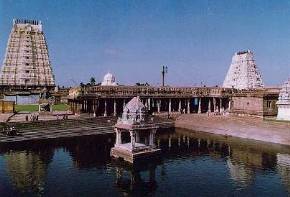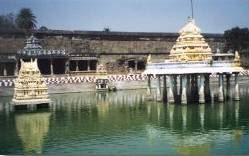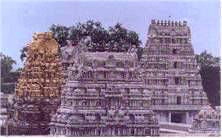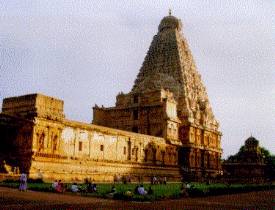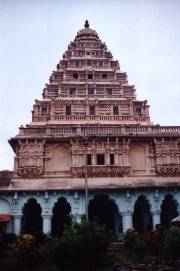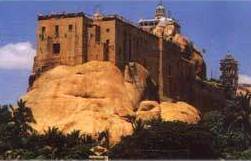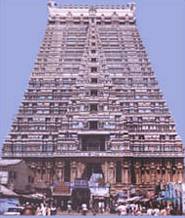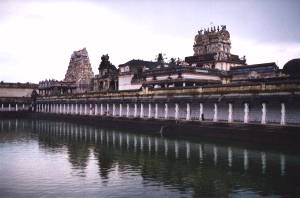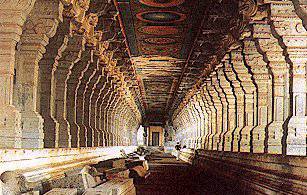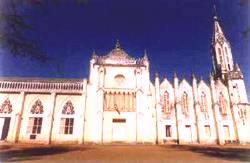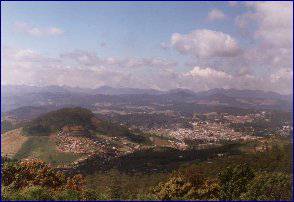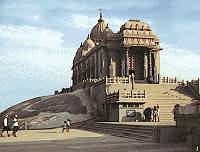The state of Tamil Nadu is in the extreme south-east of India. Its area is 131,000 km2 and its capital is Chennai (formerly Madras). The majority of the language spoken is Tamil. Tamil Nadu is undoubtedly the most typical Hindu state because, unlike northern India, the south has suffered little Muslim influence from the Mughals. The architecture is essentially Dravidian and testifies to the richness and power of the dynasties which succeeded one another in the Middle Ages (Pallava, Chola, Pandya ...). The area offers many magnificent temples of the purest Dravidian style. The population of Tamil Nadu remains mainly rural and the industry is underdeveloped.
The climate is tropical, temperatures remain warm all year round. The best season to travel to Tamil Nadu is from January to September, knowing that the highest temperatures (around 40 ° C) are reached between April and June.
Map of the province of Tamil Nadu
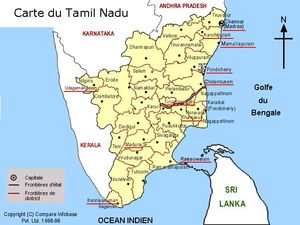
Map of Tamil-Nadu
Chennai
Capital of the state, Chennai (formerly known as Madras) has 6 million inhabitants and is the fourth city in India.
The city was founded on the coast of the Gulf of Bengal in 1639 and became the first English trading post of the East India Company. The British built a fort in 1644 around which the city developed. Baptized Madras, the city became one of the most important ports of the Gulf of Bengal and was the object of struggles of conquest between the English and the French. Madras became the capital of Tamil Nadu in 1969.
Chennai has not lost any of its Tamil culture, quite the contrary. The inhabitants are very proud of it and form a very strong resistance to the central power of Delhi. The city is still quite pleasant to live even if the level of pollution is catching up that of the other metropolises.
The industry has developed significantly in recent years and Chennai remains one of the major centers of textile handicrafts. The city is also the main center for the production of Tamil films (more films are filmed than in Mumbai.) The city has good public transport infrastructure. Anna Airport provides international flights and many domestic connections. The Egmore and Central Station railway stations offer many destinations.
The fort Saint George
It was built in the 17th century by the Compagnie des Indes Orientales to protect its interests. Today it houses the Secretariat and the Legislative Assembly. It is also the church of Santa Maria, built in 1678. It is the oldest Anglican church in India. The fort is home to a museum with many objects dating from the glorious era of the India Company.
The temple of Kapaleeswara
It was built in the 17th century by the Compagnie des Indes Orientales to protect its interests. Today it houses the Secretariat and the Legislative Assembly. It is also the church of Santa Maria, built in 1678. It is the oldest Anglican church in India. The fort is home to a museum with many objects dating from the glorious era of the India Company.
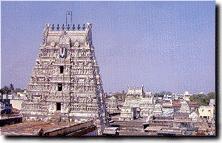
The temple of Kapaleeswara
The Cathedral of San Thome
Built in 1504 by the Portuguese, this building would house the relics of the apostle Thomas, who himself would come to preach in India. The cathedral was rebuilt in 1893.
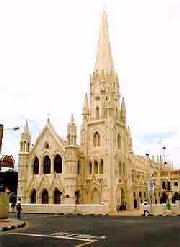
The Cathedral of San Thome
The Cathedral of Saint Andrew
Built in 1821, one can admire above all the dome painted in blue and dotted with stars.
The Supreme Court
Built in 1504 by the Portuguese, this building would house the relics of the apostle Thomas, who himself would come to preach in India. The cathedral was rebuilt in 1893.
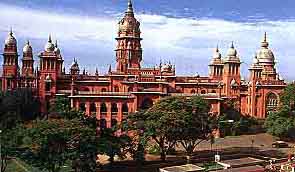
The Supreme Court
The government museum
The museum houses major geological, botanical, zoological and archaeological collections. and a superb gallery of bronzes dating from the Chola period.
The temple Sri Parthasarathy
It was built in the 8th century by the Pallava for the cult of Krishna. It was restored in the 16th century under the rule of the Vijayanagar.
Mamallapuram
Built on the Gulf of Bengal, Mamallapuram (formerly Mahabalipuram) was the great port city of the Pallava (5th-8th). She also derives her name from one of the Pallava kings, Mamalla. Compared to large cities, Mamallapuram resembles a village (14,000 inhabitants). The city stretches between its beach and a rocky promontory on which were built many small temples.
The peace, the cultural richness of the site and the proximity of the beach make of Mamallapuram a pleasant and relaxing stage. The local artisans are essentially sculptors and have made the city famous in this matter.
The shore temple
This magnificent temple, a World Heritage Site, was built in the seventh century by the sea at the height of Pallava art. The two towers house the sanctuaries. One is dedicated to Shiva , the other to Vishnu. The sea winds, the air loaded with salt and sand, have strongly eroded the delicate sculptures which surround the temple and which cover the walls, giving them a soft and round appearance.
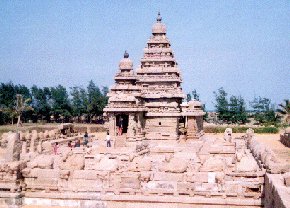
The shore temple
The asceticism of Arjuna
This immense and splendid bas-relief (27x9m) was carved on a rock. For some it represents the mythical birth of the Ganges while for others it illustrates the penance of Arjuna (one of the great personages of the Mahabharata). Having intelligently used the crack that runs up and down the rock, the sculptors represented gods, goddesses, animals, all of which were surprisingly alive.
A family of elephants is on the right side and Arjuna, standing on one leg is just to the left of the crack.
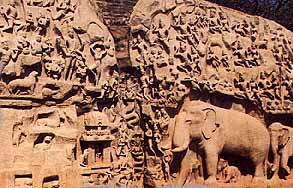
The asceticism of Arjuna
The 5 rathas
This immense and splendid bas-relief (27x9m) was carved on a rock. For some it represents the mythical birth of the Ganges while for others it illustrates the penance of Arjuna (one of the great personages of the Mahabharata). Having intelligently used the crack that runs up and down the rock, the sculptors represented gods, goddesses, animals, all of which were surprisingly alive.
A family of elephants is on the right side and Arjuna, standing on one leg is just to the left of the crack.
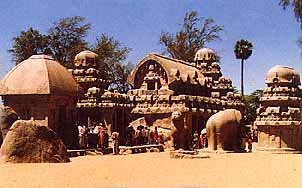
The 5 rathas
Les Mandapams
Les mandapams sont des petits temples taillés dans la roche entre le VIIe et le VIIIe siècle. Sur leurs murs on peut admirer de nombreuses statues et bas-relief. Ils sont répartis sur la colline qui surplombe Mamallapuram. Le plus célèbre et le plus beau d'entre eux et le mandapam de Krishna. On peut y voir un bas-relief montrant Krishna soulevant le Mont Govardhana pour protéger sa famille et ses vaches du déluge provoqué par Indra.
Madurai
With its 1.3 million inhabitants, Madurai is one of the major cities of South India and the second of Tamil Nadu. It is a great economic, cultural and religious center. There is an endless activity maintained by the thousands of tourists and pilgrims who go there each year. Life seems to have developed around the gigantic temple of Sri Meenakshi.
The history of Madurai goes back more than 2000 years, during the time of the Pandyan kings who made it their capital. The city was the object of the covetousness of the great dynasties which succeeded one another afterwards. It was the British who gave it its present form by shaving the fortifications surrounding the city.
The city has an airport offering regional destinations. Most tourist sites and facilities are located on the south bank of the Vaigai River. The city is renowned for the quality of its textiles and its couturiers. You will find dozens of stalls where you can, for a small price, buy you clothes tailor-made.
The temple of Sri Meenakshi
Undoubtedly the most beautiful temple of South India. Built in the 16th century, it takes its name from the daughter of a Pandyan king who met Shiva on Mount Kailash. The latter married her in Madurai as Lord Sundareshwara.
The temple has four entrances each surmounted by an immense gopuram (between 45 and 50 meters). These four towers are covered with hundreds of brilliantly colored sculptures. A real splendor. The interior surface of the temple covers 6 hectares. The mandapam with the thousand columns reaches almost the magic number since it can count 985. A museum devoted to the Hinduism is inside this mandapam. Huge galleries with painted ceilings surround the sanctuary.
Like many temples, that of Sri Meenakshi closes between 12:30 and 16:00. In the evening you can attend the ceremony during which a figure of Shiva is carried in procession to Meenakshi's room.
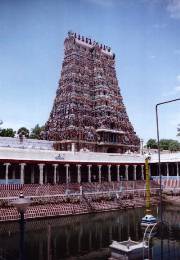
The temple of Sri Meenakshi
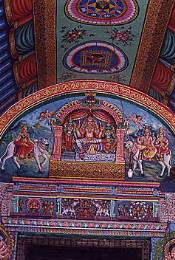
The temple of Sri Meenakshi
The palace of Thirumalai Nayak
This Indo-Muslim palace was built in 1636 under the reign of King Thirumalai Nayak. The building was largely destroyed, including its surrounding walls. Today there is only the main entrance, the dance hall and the main hall.
Between 1866 and 1872 Lord Napier, governor of Chennai, undertook major renovations. The palace was then used as a residence for British officials. The building is now run by the Department of Archeology of Tamil Nadu.
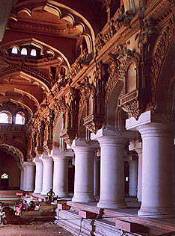
The palace of Thirumalai Nayak
The Mariamman Teppakulam Basin
It is a reservoir built on the banks of the Vaigai and in the center of which stands a promontory on which a temple was built. This basin remains mostly dry except for the festival of Teppam (feast of the Grand Bassin) in January. On this occasion the effigies of the divinities of the temple of Sri Meenakshi cross the basin on rafts and are installed inside this temple. The festival brings together thousands of faithful and lasts twelve days.
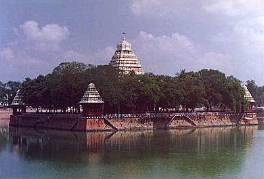
The Mariamman Teppakulam Basin
Gandhi museum
The museum occupies the former palace of Rani Mangammal built around 1670. It gives a very good insight into the history of India's independence and the life of Gandhi. . It was in Madurai that Gandhi decided not to dress any more except with the clothes of poor (dhoti). Inside, you can see the bloody dhoti he was wearing when he was assassinated in 1948.
The fest of Chithirai
It is the most popular gathering in the region. The festival takes place in late April and early May. She celebrates the marriage of Sri Meenakshi and Sundareshwara. On the tenth day of the festivities, the effigies of the two divinities are transported into the city on gigantic tanks followed by thousands of faithful.
Kanchipuram
Kanchipuram is one of the seven holy cities of India. It was the capital of the great Dravidian kingdoms (Pallava, Chola ...). Nicknamed the city of the 1000 temples, it does not count less than 125. It attracts many pilgrims and tourists. The two main currents of Hinduism, Shaivism and Vishnism, are equally represented.
The city now has 200,000 inhabitants. Its economy relies mainly on tourism and on the silk weavers who have made the city's reputation in this area.
The temple of Kailasanathar
Dedicated to Shiva and renowned for being the most beautiful temple in Kanchipuram, the temple of Kailasanathar was built in the 7th century by King Pallava Rajasimha and then completed under reign of his son Mahendra Varma.
The exterior walls are covered with sculptures and some fragments of the frescoes that adorn the niches are still visible and testify to the past splendor. It is also the only temple in the city to have been spared by the more recent architectural additions. Located outside the city, its quiet atmosphere contrasts sharply with the hustle and bustle of the downtown crowd.
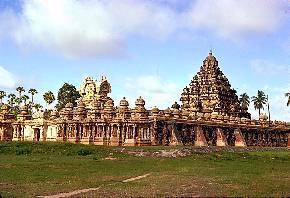
The temple of Kailasanathar
The temple of Ekambaranathar
It is one of the oldest temples of Kanchipuram and also the largest (9 hectares). It can be seen from a distance thanks to its giant gopuram 57 meters high. Its name comes from the mango tree which is inside and which is apparently 3500 years old.
The temple has a mandapam with 1000 columns (in reality 540) with all different motifs. Inside the temple 1008 liga Shiva decorate the walls.
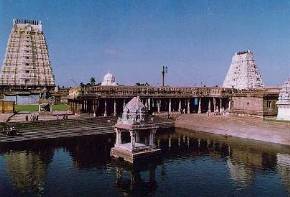
The temple of Ekambaranathar
The temple of Devarajaswamy
It is one of the oldest temples of Kanchipuram and also the largest (9 hectares). It can be seen from a distance thanks to its giant gopuram 57 meters high. Its name comes from the mango tree which is inside and which is apparently 3500 years old.
The temple has a mandapam with 1000 columns (in reality 540) with all different motifs. Inside the temple 1008 liga Shiva decorate the walls.
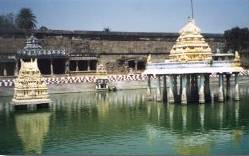
The temple of Devarajaswamy
Le temple de Kamakshi Amman
It is one of the oldest temples of Kanchipuram and also the largest (9 hectares). It can be seen from a distance thanks to its giant gopuram 57 meters high. Its name comes from the mango tree which is inside and which is apparently 3500 years old.
The temple has a mandapam with 1000 columns (in reality 540) with all different motifs. Inside the temple 1008 liga Shiva decorate the walls.
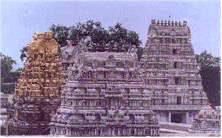
The temple of Kamakshi Amman
Thanjavur
Today, Thanjavur is the capital of the Chola dynasty, at the height of its peak between the 10th and 14th centuries. The numerous temples of the Thanjavur region, built at that time, still bear witness to the past influence of the Chola kings.
The city is known for the quality of its musical instruments, its silk and for its school of painting. The artists of Thanjavur used to paint Krishna with white skin and not blue or black as tradition.
The temple of Bridhadishwara
Built by King Raja Raja in the 10th century, this monument has been declared a World Heritage Site by both Chola's architecture and splendor. The temple is dominated by a gigantic tower 63 meters high surmounted by an enormous granite dome whose mass was estimated at more than 80 tons. To place it at the top of the tower, the temple architects probably built a gently sloping ramp 2km long.
At the entrance to the temple is a large monolithic statue of Nandi (sacred mount of Shiva) 3 m high and 6 m long. Access to the temple is permitted to all but only Hindus can enter the holy of holies. The statues and paintings in the temple testify to the Shivaite but also Vishnuite and Buddhist influence. 250 lingams are distributed in the temple.
Note that a museum is inside the temple. There is a large collection of sculptures and photographs showing the temple before its restoration.
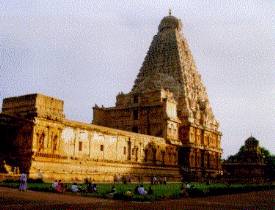
The temple of Bridhadishwara
The palace
This immense building with long corridors and large rooms was built in the city by the Nayaks around 1550 and partly by the Marathes.
It now houses the Royal Museum, an art gallery and a library. The museum displays various objects dating from the reign of Serfoji II at the beginning of the 19th century, such as headdresses, hunting weapons, clothing, etc. The gallery is housed in the Nayak Nurbar Hall and houses a large collection of bronze and granite statues dating back to the Chola period. The Saraswati Mahal library is closed to the public but you can admire some rare pieces in its museum.
Do not forget to climb up the recently renovated Clock Tower which will allow you to have a splendid view of the city and its surroundings.
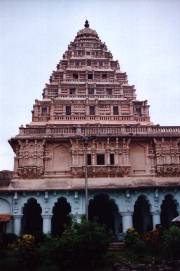
The palace
Tiruchirappalli
The history of Tiruchirappalli (formerly Trichy) dates back to the Chola and Pallava dynasties which had made it a fortress. Most of the citadel buildings still visible were built in the 16th century under the Nayak of Madurai. Tiruchirappalli was also the scene of violent clashes between French and English in the 18th century.
The Rock Fort Temple
The town of Tiruchirappalli is dominated by a rocky promontory 83m high. The Pallava dug mandapam, but it was the Chola who decided to build a fortress there. To climb there, you will have to climb 437 steps abruptly carved in the rock. Up there, a splendid panorama extends over the city and the region.
Two temples were built on the rock: the temple of Vinayaka and the temple of Sri Thayumanaswamy with its room with one hundred columns.
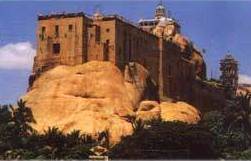
The Rock Fort Temple
The temple of Sri Ranganathaswamy
This immense temple, one of the largest in India, is surrounded by no less than seven concentric enclosures. The entrance to the temple itself is only on the level of the fifth, the four preceding ones surround dwellings and shops.
Many gopuram (about twenty) were built by the various rulers who dominated the region. The last of them, which is also the largest (73m) was completed in 1987.
The temple is mainly devoted to Vishnu but many other deities are revered. The walls, the paintings and the sculptures are very well preserved. Many mandapam are located inside.
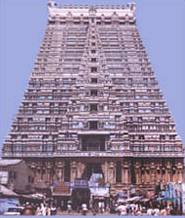
The temple of Sri Ranganathaswamy
The temple of Sri Jambukeshwara
Built near the temple of Sri Ranganathaswamy and at the same time, it has five concentric enclosures and seven gopuram. The temple is dedicated to Shiva. In the Holy of Holies a lingam is partially submerged and watered by a natural underground source.
Chidambaram
Chidambaram is one of the oldest places of worship in India. Its importance is as religious as it is cultural and historical. The city was the capital of the Chola between 907 and 1310. It is inextricably linked to Shiva in its form of cosmic dancer: the Nataraja.
The temple of Nataraja
The origins of this temple date back to antiquity but it was especially during the reign of the Chola that it experienced its most important expansion works. It was at this time, in particular, that the saint of the saints received his golden roof. Today it covers 13 hectares. Four huge gopurams (between 40 and 50 meters) rise to the four main entrances. On the east and west towers are carved the 108 academic poses of the bharata natyam.
The temple has five courtyards: the Nritta Sabha, the Deva Sabha, the Kanaka Sabha, the Chit Sabha and the Raja Sabha. The Shaba Nritta which is actually a carved structure in the form of a processional chariot. The Raja Sabha has a hall with a thousand columns, 103 m long and 58 wide. In the Kanaka Shaba is a sacred figure of Nataraja and is covered with a golden roof. Adjacent to Kanaka Shba, the Chit Sabha (Hall of Knowledge) is the most sacred sanctuary of the temple. Here are the effigies of Nataraja and Parvati (Sivakami).
Shiva is called Nataraja when he performs the dance of creation (ananda tandavam). Six religious services are held every day and can be attended. The last, around 10 pm, is the most spectacular. The Brahmans carry a statue of the Nataraja in her bedroom with a great deal of drum sounds, bells, all illuminated by torches. The Hindus believe that all the deities of the pantheon attend this ceremony.
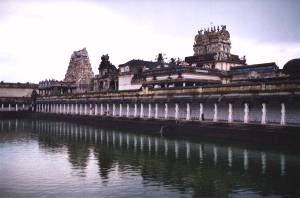
The temple of Nataraja
Rameswaram
Nicknamed "the South Varanasi", Rameswaram is one of the most important pilgrimage centers of India. Venerated by both the Shivaites and the Vishnuites, it is here that Rama, one of the avatars of Vishnu, would have thanked Shiva after defeating Ravana who had abducted his wife Sita.
The city is built on an island in the Gulf of Mannar and is connected to the mainland by the Indira Gandhi Bridge.
The temple of Ramanathaswamy
Its construction began in the 12th century and, like many temples, was enlarged by the successive sovereigns in the region.
According to legend, it was here that Rama decided to erect a lingam to thank Shiva. He asked Hanuman to go and cut the lingam in the Himalayan rocks, but seeing that the latter was slow to come back, Sita built a lingam with sand. On his return; Hanuman noticed that it was too late. To console him, Rama decided to install the two lingams and demanded that Hanuman should be venerated first. The tradition is still alive.
The temple is best known for its huge corridors lined with sculpted columns (there are more than 1,200 meters of 1220 meters of galleries) and by its 22 sacred basins whose waters all have a different taste.
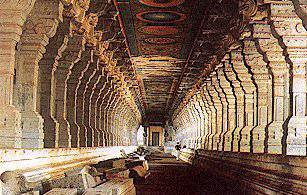
The temple of Ramanathaswamy
The temple of Kothandaraswamy
Located on the eastern tip of the island, 12 km from Rameswaram and close to the village of Dhanushkodi, the temple was the only building to withstand the cyclone that devastated this part of the island in 1964. The temple was built at the place where Vibishana, the brother of Ravana, the captor of Sita, went to Rama.
The Gandamadana Parvatham
This sanctuary, built at the top of a hill which is the highest point of the island north of Rameswaram, is supposed to contain the footprints of Rama.
Church of the Rosary
This church bears witness to the presence of Catholics. The first Christians arrived in the region in the sixteenth century with Saint Xavier.
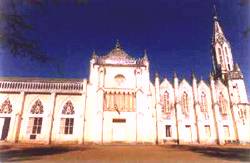
Church of the Rosary
Udhagamandalam
Called formerly Ooty by the English, Udhagamandalam is nicknamed "the Queen of the Nilgiri Mountains." The British founded a climatic station to escape the heat of the plain. Located at 2,240 meters above sea level, bordered by tea plantations, the city offers a haven of freshness for the tired traveler.
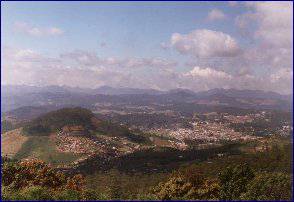
Landscape of Udhagamandalam
The botanical garden
This garden contains a wide variety of exotic and ornamental plants. A 20-million-year-old fossil tree is in the center of the garden. Every year, in May, the Festival of Flowers is held.
The miniature train
This train runs from Mettupalayam to Ooty. It crosses the 46 km hillside and offers a superb view of the Nilgiri.
Around
The city offers little appeal on its own. On the other hand, the area offers many starting points for hiking, horseback riding or boat trips on the lake.
Kanyakumari
This small town (19,000 inhabitants) is located at the extreme southern tip of India. The Europeans had named it Cap Comorin. In addition to this exceptional geographical situation, Kanyakumari is a great Hindu pilgrimage center.
The temple of Kumari Amman
This temple, built by the sea, is dedicated to the virgin goddess Kanya Devi (Parvati). According to the legend Devi did penance in this place to attract the favors of Shiva that she wanted to marry. Unfortunately Devi and Shiva were able to meet and she vowed to remain a virgin. The statue of the goddess carries a diamond in the nose so brilliant, it is said, that one can see it from the sea.
It is this temple that attracts thousands of pilgrims each year. At the foot of it there are ghats which enable the faithful to perform their ritual ablutions. Men must enter the chest naked in the temple.
Vivekananda memorial
Off the town, about 200 meters from the coast, are two rocky islands. This is where the great philosopher Swami Vivekananda came to meditate there in 1892. In 1970 a mandapam was built to celebrate this act of faith. Ferries departing from Kanyakumari provide easy access.
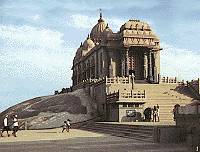
Vivekananda memorial
The Gandhi memorial
This memorial rises near the temple of Kumari Amman. It was there that the urn containing the ashes of Gandhi was exposed to the public before their dispersal at sea. It was constructed in such a way that every 2 On October, the anniversary of Gandhi, the sun comes to light the place where the urn was laid.
See also:





